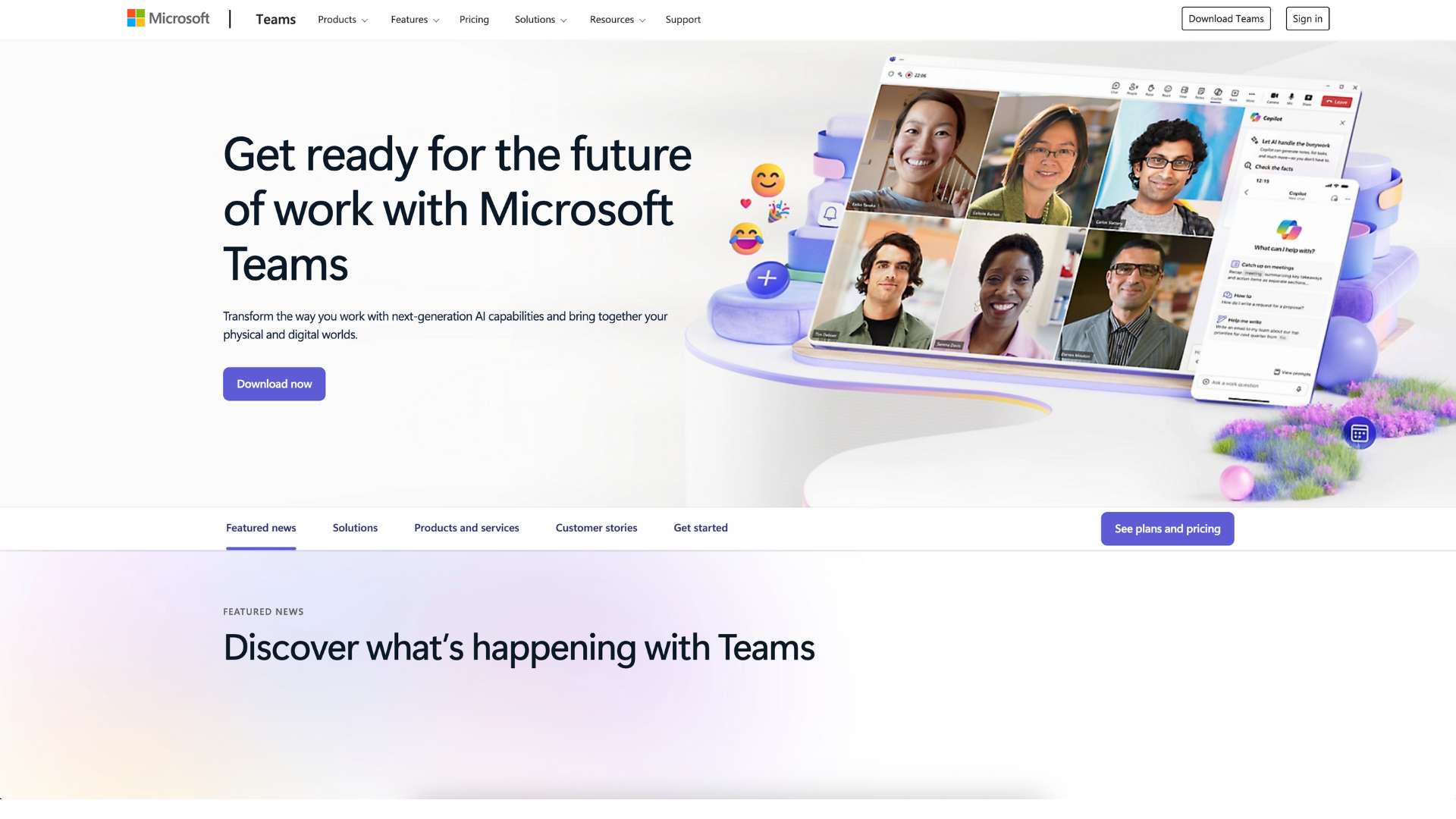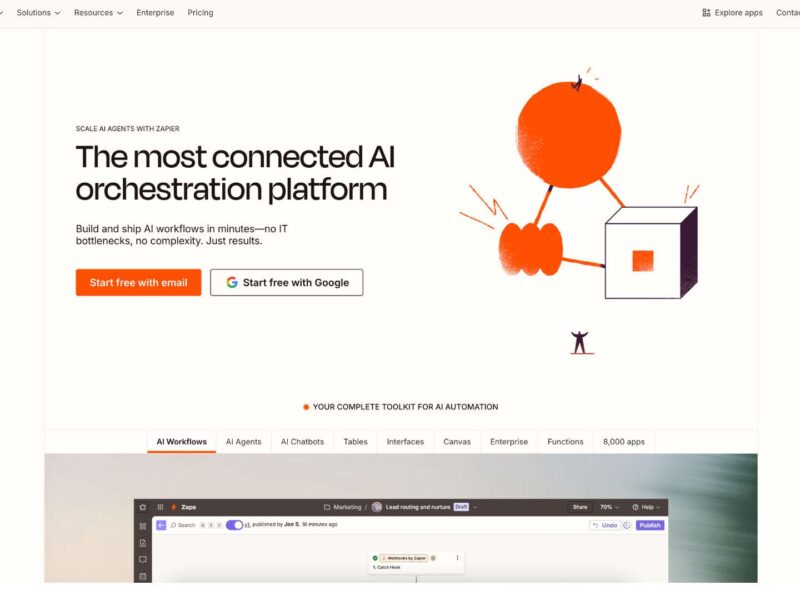Microsoft Teams Review (2025): Features, Pricing, Pros & Cons
Microsoft Teams is one of the most powerful collaboration tools available in 2025. Built for remote work, hybrid teams, and enterprise communication, it combines messaging, video conferencing, file sharing, and project collaboration into a single, cloud-based platform.
Teams is part of the Microsoft 365 suite, making it a natural choice for businesses already using tools like Word, Excel, and Outlook.
The platform solves one of the biggest issues facing modern teams: fragmentation. In an era where workforces are distributed and projects rely on multiple software platforms, Microsoft Teams brings everything under one virtual roof.
No more jumping between Slack, Zoom, Google Docs, and Trello—Teams centralizes the workflow.
It’s ideal for enterprises, educators, government institutions, startups, and remote teams looking for secure and scalable collaboration tools.
About Microsoft Teams
Microsoft Teams was launched in 2017 by Microsoft Corporation to compete directly with Slack and other team communication tools. Developed as part of the Microsoft 365 suite (formerly Office 365), the product quickly evolved from a basic messaging app into a full-fledged collaboration platform.
Headquartered in Redmond, Washington, Microsoft saw a meteoric rise in Teams usage during the COVID-19 pandemic. It now serves over 300 million monthly active users globally, ranging from Fortune 500 companies to small nonprofits.
Teams was designed to be more than a chat tool—it was built as a digital workplace hub where users could host meetings, collaborate on documents in real time, assign tasks, and access over 700 third-party apps.
Official website: https://www.microsoft.com/en-us/microsoft-teams
Key Features of Microsoft Teams
Communication
- 1-on-1 and Group Chat: Keep all communications organized with threaded messages, mentions, and reactions.
- Channels: Public or private channels for team or department-based communication.
- Persistent Conversations: Keep track of history across devices and time zones.
- Rich Media Messaging: Share GIFs, stickers, links, and formatted code blocks.
Video and Audio Conferencing
- Instant or Scheduled Meetings: Schedule with Outlook or host spontaneous calls.
- Webinars and Events: Host up to 10,000 participants in webinars with advanced controls.
- Breakout Rooms: Split meetings into smaller group sessions.
- Live Captions & Transcription: Enhance accessibility and post-meeting documentation.
- Recording: Cloud recording with transcription and permission settings.
File Sharing and Collaboration
- Integrated with OneDrive & SharePoint: Store, share, and manage files with version history.
- Real-Time Co-authoring: Collaborate in Office documents right within Teams.
- Tabs and Pinned Files: Create easy access points to important resources.
App Integrations
- Microsoft Ecosystem: Deep integration with Outlook, Excel, Power BI, and more.
- Third-Party Apps: Add tools like Asana, Trello, Jira, Salesforce, or even Zoom.
- Custom Bots and Workflows: Use Power Automate to create automation rules and responses.
Task and Project Management
- Planner and To Do: Assign, manage, and track tasks in shared boards.
- Approvals: Built-in request and approval workflows.
- Calendar Views and Notifications: Keep everyone aligned on deadlines.
Security and Compliance
- Enterprise-Grade Security: Multi-factor authentication, encryption at rest/in transit.
- Compliance Tools: eDiscovery, legal hold, audit logs.
- Standards Supported: HIPAA, ISO 27001, SOC 2, GDPR, FedRAMP.
User Interface and Experience (UI/UX)
Microsoft Teams features a modern, unified interface with left-hand navigation for Chat, Teams, Calendar, Calls, and Files. While powerful, the interface can feel overwhelming due to the abundance of features and layered menus.
- Onboarding: Microsoft provides built-in tutorials, guided prompts, and tips. First-time users are walked through basic functions like joining a team, creating a channel, and scheduling a meeting.
- Mobile App: The iOS and Android apps are feature-rich and stable, with offline chat access and push notifications.
- Accessibility: Supports keyboard shortcuts, screen readers, live captions, and immersive readers.
However, the interface becomes cluttered when managing many channels, apps, and meetings—especially in large organizations.
Platforms Supported
| Platform | Supported | Notes |
|---|---|---|
| Web Browser | Yes | Chrome, Edge, Safari, Firefox |
| Windows | Yes | Full-feature desktop application |
| macOS | Yes | Desktop app available |
| Android | Yes | Full functionality, regular updates |
| iOS | Yes | Compatible with iPhones and iPads |
| Linux | Yes | Web version recommended |
| Cloud-Based | Yes | Fully cloud-native platform |
| Offline Access | Partial | Offline chat access only; meetings require connection |
Microsoft Teams Pricing (2025)
| Plan | Monthly Price (USD) | Key Features |
|---|---|---|
| Microsoft Teams Free | $0 | Unlimited chat, 60-min meetings, 5 GB storage |
| Microsoft 365 Business Basic | $6.00/user | Teams + web Office apps, 1 TB OneDrive, 300-user meetings |
| Microsoft 365 Business Standard | $12.50/user | Desktop Office apps, email, Teams |
| Office 365 E3 | $23.00/user | Enterprise-level features, advanced security |
| Microsoft 365 E5 | $38.00/user | Compliance, analytics, security, and Power BI Pro |
- Free Trial: 30-day free trial for all business plans
- Discounts: Available for education, nonprofits, and annual payments
Pros and Cons
Pros
- Native integration with Microsoft Office and Outlook
- Reliable, secure, and highly scalable
- Rich feature set for remote meetings and document collaboration
- Enterprise-grade compliance and security
- Active updates and a strong product roadmap
Cons
- Can feel bloated and confusing to new users
- Notification settings are complex to manage
- High system resource usage on older devices
- Occasional sync issues in large teams
- Search functionality is less intuitive than competitors
Customer Support and Resources
- Support Channels:
- Live chat (for paid users)
- Email and ticketing system
- Community forums
- Availability:
- 24/7 for enterprise customers
- Documentation:
- Extensive Microsoft Learn modules
- In-depth video tutorials and instructor-led webinars
- Community:
- Large user base, active Reddit forums, and YouTube walkthroughs
Microsoft also offers personalized onboarding for large accounts through its FastTrack program.
Real-World Use Cases / Ideal Users
Large Corporations and Global Teams
Multinational companies use Microsoft Teams to unify internal communication across time zones, manage projects with Planner, and host executive briefings or training sessions. Legal and finance departments benefit from secure file sharing and compliance features.
Schools and Educational Institutions
From K-12 classrooms to universities, Teams has become a virtual learning environment. Features like class notebooks, assignments, and built-in quizzes make it ideal for educators and students collaborating remotely.
Creative Agencies and Freelancers
Agencies set up client-specific channels, share pitch decks, and use third-party integrations like Adobe Creative Cloud or Trello. Freelancers benefit from having everything—video calls, contracts, files—in one interface.
User Reviews and Ratings
| Platform | Rating (Out of 5) | Summary Feedback |
|---|---|---|
| G2 | 4.3 | Powerful but UI-heavy |
| Capterra | 4.5 | Best for Microsoft users |
| Trustpilot | 3.8 | Great meetings, complex navigation |
Sample Quotes:
- “The ability to co-edit documents during meetings is a game changer.” – Rebecca T., HR Director (G2)
- “It’s like Slack and Zoom had a baby, but sometimes that baby cries a lot.” – Jason L., Marketing Lead (Trustpilot)
Best Microsoft Teams Alternatives
| Alternative | Best At | Key Difference |
|---|---|---|
| Slack | Chat-focused collaboration | Smoother UI, but weak on meetings |
| Zoom | Video conferencing | Best video quality, lacks file tools |
| Google Chat + Meet | Lightweight team collaboration | Easier setup, limited depth |
| Webex | Enterprise video solutions | Similar features, clunkier UI |
| ClickUp | Task/project management with chat | Better for managing tasks, not calls |
Summary
Microsoft Teams is one of the most comprehensive platforms for team communication and collaboration in 2025. With its tight integration into the Microsoft 365 ecosystem, it covers nearly every aspect of modern work, from messaging and meetings to file collaboration and task tracking.
It’s a natural fit for organizations already using Microsoft tools. However, it may feel overengineered for very small teams or those preferring minimalist tools. For enterprises, educational institutions, and hybrid workplaces, it delivers on security, scalability, and productivity.
If you want to unify your digital workspace under one roof, Microsoft Teams is a reliable choice worth considering.
Ready to explore Teams? Visit Microsoft Teams Official Site
Or compare it with similar collaboration tools on usefully.site
Media
How To Use The NEW Microsoft Teams 2025 (Latest Version)
Microsoft Teams for Beginners (2024)
10 New Features in Microsoft Teams for 2025


